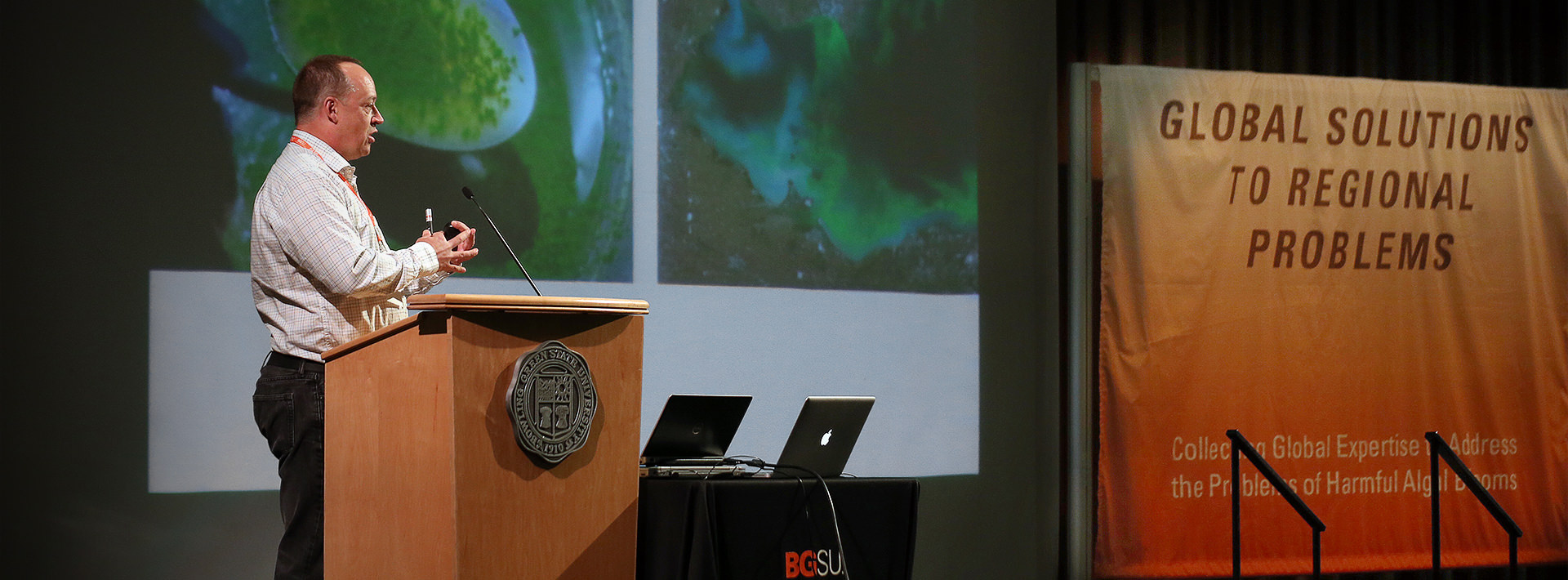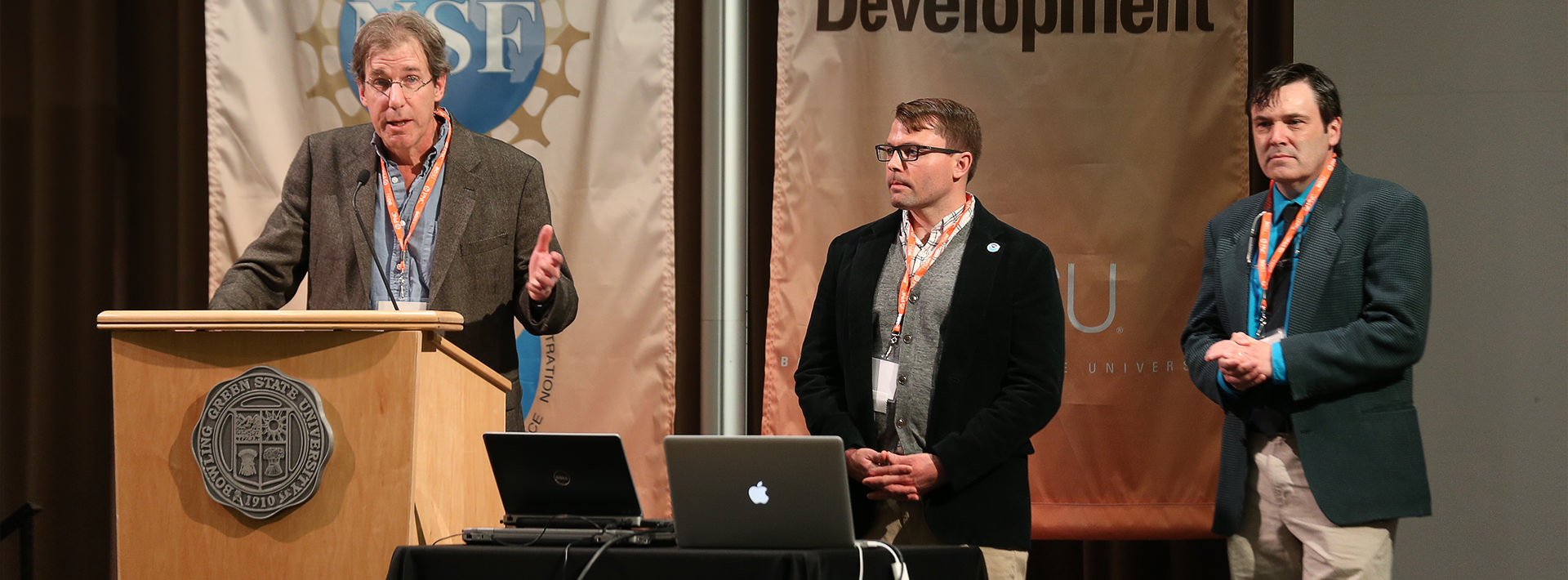Toxic Water
Workshop takes closer look at harmful algal blooms

By Jen Sobolewski
In freshwater lakes around the world, a blue-green slick is often seen floating on the water. These algae blooms often result from an overabundance of what's known as cyanobacteria, or blue-green algae, which may be toxic to humans and other animals.
This bacteria clumps into mats that cover a lake's surface from one shore to the other, using up oxygen in the water and eventually turning the lake's depths into a dead zone.
Bowling Green State University hosted a workshop on April 13 and 14 to take a closer look at these harmful algal blooms, or HABs, which exist worldwide. During “Global Solutions to Regional Problems: Collecting Global Expertise to Address the Problem of Harmful Algal Blooms,” researchers from five countries and 15 states discussed the current science on algae blooms, and identified knowledge gaps in bloom prevention and mitigation. The National Science Foundation and The National Oceanic and Atmospheric Administration (NOAA) sponsored the workshop.
Meeting topics included the biology of bloom-forming species, environmental factors underlying bloom formation, sensor development in bloom detection, prediction of blooms, and best practices for control.
"The workshop successfully brought together experts who often do not have the opportunity to share ideas on how cyanobacterial blooms form and can be mitigated,” said Dr. George Bullerjahn, a professor of biology at BGSU and co-organizer of the workshop.
“The event really put BGSU on the map in terms of this globally-important issue,” said co-organizer Dr. Mike McKay, Ryan Professor of Biological Sciences at BGSU. “Devastating large-scale harmful algae bloom events are becoming increasingly frequent and in part because of the success of this workshop, and the networking opportunities that it provided, BGSU will be looked upon to help lead the fight to mitigate and prevent harmful algae blooms in the future.”
Here in northwest Ohio, toxic blooms often affect Lake Erie. In 2011, a record-breaking bloom smothered the lake, turning it a bright green that showed up on satellite images. Last August, a bloom affected the water intake for the city of Toledo and much of northwest Ohio, leading to a “do not drink” order for several days.
“As a scientific community we have made great strides in what we know about the cyanobacteria and what produces the toxins. We know much about the who, the what, the where and when, but we know less about the why. We are still trying to understand why they produce these toxic compounds,” said Dr. Tim Davis, a molecular HAB ecologist at NOAA.
“Harmful algal blooms, while they are an issue, they are the symptom of a larger issue, which is excess nutrients into our system,” he said.
The complex chain that leads to algae blooms in freshwater begins not in lakes but on land. Farmers often over fertilize their fields. The excess fertilizer, laden with nutrients like phosphorus and nitrogen, washes into creeks and rivers, where it's eventually carried to lakes.
Only a fraction of the nitrogen applied to soils ends up in crops; in some regions, it's less than 20 percent. When the excess eventually reaches freshwater, it fertilizes aquatic algae such as cyanobacteria—just as it encourages plants on land to grow. The algae proliferate, becoming massive blooms.
“In order to mitigate and reduce the blooms in our lakes all over the world we have to take great strides in reducing our footprint. This is a long-term solution and the only long-term solution that we recognize as a community. If we reduce the nutrient load, then we will reduce the blooms,” Davis explained.
 Bullerjahn said he was particularly interested in the growing consensus among the workshop attendees that nitrogen and phosphorus need to considered in management decisions moving forward. “Additionally, the advice provided by the participating economists showed the potential for incentivizing land use decisions that can reduce nutrient inputs from the landscape.”
Bullerjahn said he was particularly interested in the growing consensus among the workshop attendees that nitrogen and phosphorus need to considered in management decisions moving forward. “Additionally, the advice provided by the participating economists showed the potential for incentivizing land use decisions that can reduce nutrient inputs from the landscape.”
As part of the workshop, an open forum was held April 14 where area residents and business owners could discuss how these algal blooms affect them and what they feel needs to be done to better inform the public.
NOAA hosted the event and the comments they collected will be submitted to Congress in June as part of the Harmful Algal Bloom and Hypoxia Research and Control Amendments Act of 2014.
“We have come up with a series of tools the last 5-10 years that we hope will be of interest to our stakeholders, including predicting when and where harmful algal blooms will happen and methods for early warnings. We are incorporating those in a very site-specific way,” said Davis.
NOAA representatives asked the over 60 attendees for their input on:
- Regional priorities for ecological, economic and social research on the causes and impacts of HABs and low oxygen;
- Improved monitoring and early warning, and new approaches to prevention, control and mitigation;
- Communication and information dissemination methods that state and local governments may use to educate and inform the public;
- An action strategy for managing future situations.
Many of the attendees expressed a need for better reporting mechanisms, even going as far as to say that reports about the health of Lake Erie should be included in daily weather reports on local TV newscasts. One business owner said the dissemination of information must be simpler.
“I want to log in to a website and see if it’s safe to swim in the water, is it safe to go fishing or take my kids into the lake. I don’t think the forecast at present can do that right now.”
Concerns were also expressed about a lack of accurate information. One attendee suggested that the U.S. Environmental Protection Agency create a website that explains in detail what you can and cannot do if a harmful algal bloom has tainted the water supply.
One board member of the Lakeside Community in Ottawa County said the health of Lake Erie directly affects their economy, and better reporting systems do him no good.
“The only outcome that works for us is to eliminate this problem,” he told the group. “Telling me early about it—once it’s there it’s too late. People stop coming to the lake and the tourism in that part of the lake is dead.”
Another stakeholder mentioned a lack of accountability. “Is the lake getting healthier, or sicker?” she asked. “That’s what I want to know. How do we measure that? We need to say what you are doing is or isn’t working.”
“We want to give a message of hope that we are moving in the right direction. We’ve made great strides in understanding HABs and are continuing to do that as a collective body,” said Davis.
“We know why these blooms occur; however, given the socio-economic landscape in which we live, addressing the problem will be long-term and will require creative solutions,” said McKay.
Updated: 12/02/2017 12:44AM
